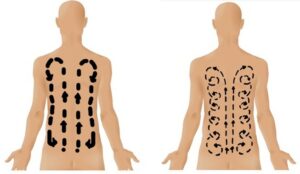4.5 Back Rub
Back rubs can conveniently be given after baths, before bedtime, or after repositioning. Back rubs help boost relaxation, stimulate circulation, and promote sleep. Back rubs do not need to be long, and typically take about 5 minutes of your time. Always ensure it is okay to provide a back rub. Health Care Assistants must check with their supervisor and check the care plan. Again, giving a back rub gives the HCA the opportunity to observe skin condition for rashes, bruises, red, white, or open areas, and other signs of skin breakdown. Always report and record observations of any changes in skin condition.
Purpose for Giving a Back Rub
- To give comfort
- To stimulate blood circulation
- To promote rest and sleep
- To prevent pressure sores
- To observe the skin condition
- To relax and relieve tension in tissues and muscles
- To refresh the client and relieve fatigue
General Instructions for Giving a Back Rub
- Back care is given as a part of A.M. care and P.M. care.
- When giving a back rub, use more pressure (gentle) on the upward strokes towards the head and less pressure on the downward strokes.
- Back rubs may be contraindicated in clients susceptible to clotting disorders — check with the supervisor.
- Do not take your hands off of the client’s back until the end of the procedure.
- Stop the back rub if, at any time, the client reports discomfort or no longer wishes you to continue.
| STEP | ACTION | REASON |
|---|---|---|
| 1. | Explain the procedure and position to the client. | |
| 2. | Perform hand hygiene and gather all supplies. | Good organization is time efficient. |
| 3. | Adjust bed to a comfortable height. | Prevent back strain and injury. |
| 4. | Provide privacy and adjust the light, temperature, and sound in the room. | Client comfort. |
| 5. | Lower the side rails and help the client assume a prone or side-lying position (Sim’s position). | |
| 6. | Expose the client’s back, shoulders, upper arms, and buttocks, and cover the remainder of the body. | |
| 7. | Use lotion that has been warmed in a basin of warm water, or by running the bottle under warm water for a few minutes. | Do not heat lotion in the microwave. Rationale: It may explode or be too hot and burn the skin. |
| 8. |
|
This lubricates your hands during the back rub, and helps warm the lotion so the client does not feel too cold. |
| 9. |
|
Use gloves only if you or the client have any open cuts, wounds, or sores to prevent infection. |
| 10. | Continue this massage pattern for about 2–3 minutes. | |
| 11. | You may change the pattern to small circular motions, either making a circular movement moving upward along the spine and outward from the spine, and laterally alongside the back, down to the iliac crest (hip) or downward and inward toward the spine (see Figure 4.5.1) | |
| 12. | Continue this massage pattern for about 2–3 minutes. |
 |
| 13. | When you are almost done with the back rub, let the client know so they are prepared for the ending of their back rub. | |
| 14. |
|
|
| 15. |
|
|
| 16. | Put away equipment and supplies. Dispose of any dirty linens. | |
| 17. | Wash and dry your hands. | |
| 18. | Document the client’s response and record any changes in condition or behaviour. |
Watch the video:
Backrub Skills Demonstration by Frances Payne Bolton School of Nursing (2010).
Key Takeaways
Back rubs are important because they:
- Provide relaxation and comfort.
- Can be given as part of the bathing process or in the evening care.
- Are soothing and often a highlight for the immobile client.
- Help prevent skin breakdown.
- Offer direct observation of the client’s skin condition.

